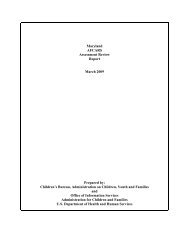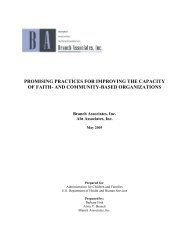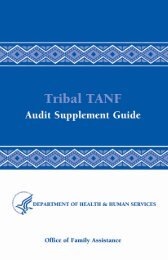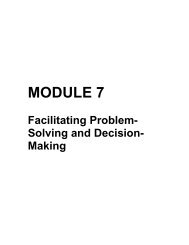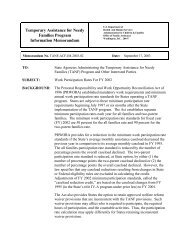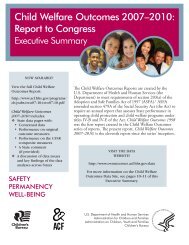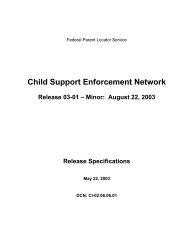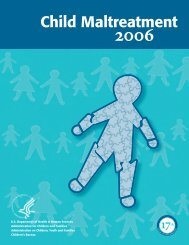Final Report of the Subcommittee on Domestic Trafficking
Final Report of the Subcommittee on Domestic Trafficking
Final Report of the Subcommittee on Domestic Trafficking
Create successful ePaper yourself
Turn your PDF publications into a flip-book with our unique Google optimized e-Paper software.
With respect, we believe you are asking <str<strong>on</strong>g>the</str<strong>on</strong>g> wr<strong>on</strong>g questi<strong>on</strong>.Trafficked pers<strong>on</strong>s are receiving services at an inappropriately low rate whatever <str<strong>on</strong>g>the</str<strong>on</strong>g>ircountry <str<strong>on</strong>g>of</str<strong>on</strong>g> origin. This appears to be <str<strong>on</strong>g>the</str<strong>on</strong>g> case despite what we see as outstanding effortand dedicati<strong>on</strong> <strong>on</strong> <str<strong>on</strong>g>the</str<strong>on</strong>g> part <str<strong>on</strong>g>of</str<strong>on</strong>g> various government agencies to address <str<strong>on</strong>g>the</str<strong>on</strong>g> vexing problem<str<strong>on</strong>g>of</str<strong>on</strong>g> trafficking within our borders.The lamentably low rate <str<strong>on</strong>g>of</str<strong>on</strong>g> access to trafficking services for internati<strong>on</strong>al victims is indirect proporti<strong>on</strong> to <str<strong>on</strong>g>the</str<strong>on</strong>g> low rate <str<strong>on</strong>g>of</str<strong>on</strong>g> <str<strong>on</strong>g>of</str<strong>on</strong>g>ficial victim identificati<strong>on</strong>. When an internati<strong>on</strong>alvictim is <str<strong>on</strong>g>of</str<strong>on</strong>g>ficially recognized as a victim and c<strong>on</strong>curs with <str<strong>on</strong>g>the</str<strong>on</strong>g> terms <str<strong>on</strong>g>of</str<strong>on</strong>g> <str<strong>on</strong>g>the</str<strong>on</strong>g> TVPA forcertificati<strong>on</strong> or eligibility, she receives services ra<str<strong>on</strong>g>the</str<strong>on</strong>g>r expeditiously and effectively. Infive years, however, we are discussing <strong>on</strong>ly about 1,200 people, including children andadults.If we accept <str<strong>on</strong>g>the</str<strong>on</strong>g> Department <str<strong>on</strong>g>of</str<strong>on</strong>g> State estimates <str<strong>on</strong>g>of</str<strong>on</strong>g> numbers <str<strong>on</strong>g>of</str<strong>on</strong>g> people trafficked into <str<strong>on</strong>g>the</str<strong>on</strong>g>United States from foreign countries (between 14,000-17,500), most, <str<strong>on</strong>g>the</str<strong>on</strong>g>n, are notidentified or, even if identified, are frequently deported ra<str<strong>on</strong>g>the</str<strong>on</strong>g>r than provided services.This is shockingly <str<strong>on</strong>g>the</str<strong>on</strong>g> case even for children. While it is Americans who are patr<strong>on</strong>izing<str<strong>on</strong>g>the</str<strong>on</strong>g> bro<str<strong>on</strong>g>the</str<strong>on</strong>g>ls, are pr<str<strong>on</strong>g>of</str<strong>on</strong>g>iting from forced labor or using slave-made goods, <str<strong>on</strong>g>the</str<strong>on</strong>g> traffickedpers<strong>on</strong>s are too <str<strong>on</strong>g>of</str<strong>on</strong>g>ten not receiving <str<strong>on</strong>g>the</str<strong>on</strong>g> services outlined for <str<strong>on</strong>g>the</str<strong>on</strong>g>m by <str<strong>on</strong>g>the</str<strong>on</strong>g> TVPA. Too feware being rescued and restored.Americans who are similarly victimized (whe<str<strong>on</strong>g>the</str<strong>on</strong>g>r or not <str<strong>on</strong>g>the</str<strong>on</strong>g>ir victimizati<strong>on</strong> is calledtrafficking) are also sometimes not able to receive services; not because <str<strong>on</strong>g>the</str<strong>on</strong>g>y will beremoved from <str<strong>on</strong>g>the</str<strong>on</strong>g> country but because our social service systems are overburdened to <str<strong>on</strong>g>the</str<strong>on</strong>g>point that many, many people slip through <str<strong>on</strong>g>the</str<strong>on</strong>g> cracks.Thus we think that <str<strong>on</strong>g>the</str<strong>on</strong>g> correct questi<strong>on</strong> is <str<strong>on</strong>g>the</str<strong>on</strong>g> following: “What barriers preventtrafficking victims from our own or o<str<strong>on</strong>g>the</str<strong>on</strong>g>r countries from receiving needed protecti<strong>on</strong> andservices and what should/can we do to remove or lower those barriers?”Barriers to service—internati<strong>on</strong>al victimsThe greatest barrier that we see to internati<strong>on</strong>al victims receiving services is <str<strong>on</strong>g>the</str<strong>on</strong>g>reluctance <str<strong>on</strong>g>of</str<strong>on</strong>g> federal law enforcement <str<strong>on</strong>g>of</str<strong>on</strong>g>ficials to request that victims have access toavailable services. In <str<strong>on</strong>g>the</str<strong>on</strong>g> immediacy <str<strong>on</strong>g>of</str<strong>on</strong>g> a raid or law enforcement acti<strong>on</strong>, victims do notfeel safe telling law enforcement <str<strong>on</strong>g>of</str<strong>on</strong>g> <str<strong>on</strong>g>the</str<strong>on</strong>g>ir true circumstances and law enforcementpers<strong>on</strong>nel do not have <str<strong>on</strong>g>the</str<strong>on</strong>g> time to dig deeply bey<strong>on</strong>d <str<strong>on</strong>g>the</str<strong>on</strong>g>ir first answer. Thus, victims areremoved from <str<strong>on</strong>g>the</str<strong>on</strong>g> country before <str<strong>on</strong>g>the</str<strong>on</strong>g>y have an opportunity to understand <str<strong>on</strong>g>the</str<strong>on</strong>g>ir opti<strong>on</strong>sand agree to assist in law enforcement activity. In <str<strong>on</strong>g>the</str<strong>on</strong>g> case <str<strong>on</strong>g>of</str<strong>on</strong>g> children, <str<strong>on</strong>g>the</str<strong>on</strong>g> additi<strong>on</strong>albarrier is <str<strong>on</strong>g>the</str<strong>on</strong>g> reluctance <str<strong>on</strong>g>of</str<strong>on</strong>g> HHS to <str<strong>on</strong>g>of</str<strong>on</strong>g>fer care absent a request from a federal lawenforcement <str<strong>on</strong>g>of</str<strong>on</strong>g>ficial.For internati<strong>on</strong>al adult victims or children who receive services with <str<strong>on</strong>g>the</str<strong>on</strong>g>ir parents, <strong>on</strong>cea formal referral is made service systems are in place to resp<strong>on</strong>d. Adult and familieshave been victimized in:63





